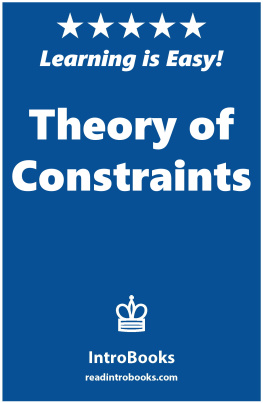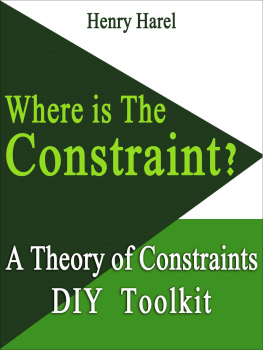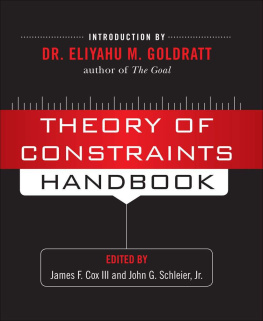Table of Contents
Theory of Constraints
IntroBooks #248
readintrobooks.com
Copyright 2016 Can Akdeniz
All rights reserved.
PREFACE
Theory of constraints is a methodology that is used by the people to identify the constraints that are standing as a hindrance in the process of accomplishing the organizations goals besides improvising the constraint to ensure that it does not stand as an obstacle. To be precise, the limitation has to be shaped in such a way that it no longer would be a constraint. Basically, in the manufacturing industry, constraint is referred by the name called bottleneck. As per the theory of constraint (TOC), each and every process that is being carried out has a constraint. It is crucial for the organizations in their respective industry to assimilate the constraints to facilitate the whole process. Without improving the constraints, it is not possible for the organizations to improve the entire process. This is better explained with an example. If someone has handed you a match box and asked you to count. Then, to start the count you would remove the match sticks from the box and after counting you would arrange them back in the box properly. So, the constraint in this is how soon the match box is handed over to you. Did the time have an impact on your counting speed? Would you have counted the matchsticks in the box more quickly, if the match box was handed over to you a little bit before? Basically, this is how the constraint will help to boost the process. However, in this e-book we will discuss about the theory of constraints in detail. However, by reading this informative e-book, you will have a thorough understanding on the below concepts of theory of constraints.
Introduction
What is the theory of constraint?
Types of constraints
Implementation of five step process in theory of constraints
Principles of theory of constraints
Real-time examples of theory of constraint
How the theory of constraints works in service organizations
Establishing relationship between operational measures and theory of constraint
Comparison of lean thinking with theory of constraints
INTRODUCTION
The theory of constraints can be better instigated with a saying that a chain is no stronger than its weakest link. This means that the organization functioning and business operations will no longer function properly, if there is one disgruntled employee in the organization. This person will totally ruin the organization functioning and consequently takes a toll on the outcome. Basically, there are constraints which stand in the way of accomplishing your goals. It is vital for you to identify the constraints and restructure the entire process by keeping the constraint in mind to ensure that the business process goes smoothly. This kind of theory is mainly applied in the manufacturing industry. This is very useful not just to improve the processes, but also in managing the people effectively. Ideally, theory of constraint is helpful to carry out both personal and professional tasks successfully. This TOC helps people to prioritize the things to be done. Basically, TOC embraces 80/20 rule. As per this rule, there are a few things that are to be done to get a positive outcome and there are majority of things that do not have any impact on the process. So, it is vital for you to focus on the minor tasks which have a great positive impact.
If you want to know about the theory of constraints, types of constraints, Implementation of five step process in theory of constraints, Principles of the theory of constraints, Real-time examples for the theory of constraint, How the theory of constraints works with service organizations, Establishing relationship between operational measures and theory of constraint and comparison of lean thinking with theory of constraints, then you need to read this e-book.
1. WHAT IS THE THEORY OF CONSTRAINT?
Theory of constraints, a process improvement methodology helps you to find out a few things that you want to achieve and what is stopping you from accomplishing those things. You need to carry out the activities either by resolving or totally preventing those constraints. Unarguably, theory of constraints take a scientific approach to improve the process. As per this theory, the manufacturing process and other complicated systems have multiple activities linked with each other, where one link will act as a constraint. Basically, the link that is considered to be a constraint is identified as a weakest link in the entire chain. Every manufacturing company wants to make a huge profit in both long and short terms. The best trait that is grabbing the attention of the organization to implement this kind of theory in their process is prioritizing the activities that have to be improved. The first priority to be given is for current constraint. To improve the process, TOC helps you to identify the methodology and implement the same to improve the process at a brisk pace.
The TOC that is successfully implemented, will help the manufacturing companies to reap the below benefits
Increases the profit margin of the organizations
Focus on the vulnerable part in the chain of activities and fix the vulnerability at a faster pace
When the constraint is addressed quickly, then you can increase the number of products to be manufactured every day
Curtail the time to manufacture a product by fixing the constraint and amplify the product flow
Totally reduce the inventory
Help to deliver the product or service within the given timeline
Reduction in the system glitches
Cut down the variable expenses in production
Easy to understand the process
As per the concept of TOC, every process will have more than one constraint, so improving the constraints will certainly improve the process. Organizations instead of spending their valuable time in improving the non-constraints should focus on constraints to reap benefits. Basically, improving the constraint will help organizations to attain the goal of making huge profits with ease. It is vital for you to address one constraint at a time and once you improve the constraint, then go to the next constraint to improve the process as a whole.
Theory of constraint - five step implementation
Identify: First, you need to identify the constraint that is standing as an obstacle from achieving your goals
Exploit: You need to make the necessary amendments to the constraints with the help of the existing resources. It is imperative for you to make the most of what you have.
Subordinate: You need to thoroughly review the other activities in the chain and ensure that they support the improvement in the constraint
Elevate: After making the improvement, in case if the constraint still exists, then you need to take other actions to completely eliminate it. You need to carry out the actions until the constraint is kept at bay. Sometimes, you need to raise capital investment to eliminate the constraint.
Repeat: Unarguably, this five step is a reiteration of the above four steps. When you fix one of the constraints in the chain, then you need to immediately address the next one to smoothen the process. It is crucial for you to improve the current constraint and move on to the next one.
What is thinking processes?
There is a brilliant problem solving methodology in the theory of constraint called thinking processes. This thinking process helps you to improve the constraints on the complicated systems. These are the scientific tools that helps you to identify the root cause of the problems and prevent them without giving a chance for the new one to rise. The thinking processes play a vital role and help you to find answers to various queries such as what should be changed, what outcome you are expecting after changes, and what are the actions to be taken to enforce the change.













